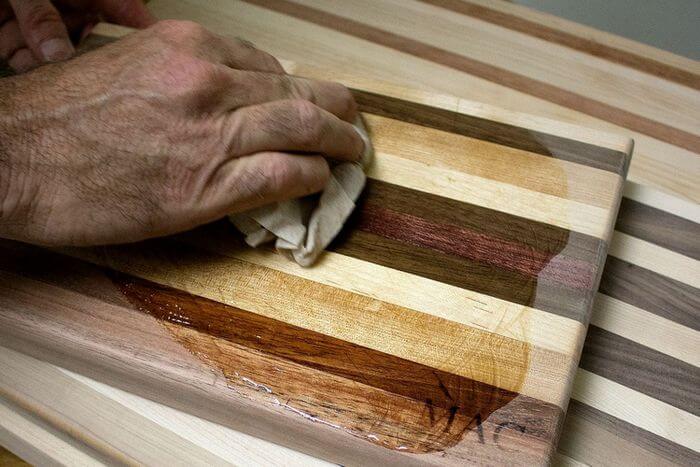When choosing a finish, the vast majority of craftsmen prefer compositions made from natural ingredients, primarily oils. There are many options for impregnating a new board, but practice shows that the most effective solution in this matter is to use vaseline oil, which is not difficult to find in a pharmacy.
An alternative to vaseline oil can be vegetable analogues, in particular, walnut or linseed oil. But, despite the environmental friendliness and simplicity of such a finish, over time it can transmit an unpleasant rancid smell to food in contact with a wooden board. When covering the product with linseed, vaseline or any other oil, you will have to periodically renew the impregnation, which will wear out as the plank is used.
How to oil a cutting board?
Impregnation oil is applied to a well-sanded and dried surface. Evenly distributing an abundant amount of the finishing composition with a brush or swab, it is allowed to soak into the wood structure (15-20 minutes), after which the excess is wiped off by running the swab along the fibers.

A new wooden cutting board is treated with at least two to three layers. Each fresh layer of oil is applied after the previous one has completely dried. This is not very convenient because vegetable oils are quite low. Drying boards must be done in a well-ventilated area.
Are other finishing compounds hazardous to health?
This question still causes heated discussions, despite the fact that unequivocal and authoritative answers have long been given to it. Any finish can be used to finish wood products in contact with food, including oil, polyurethane and nitrocellulose varnishes, shellac coatings and linen drying oil. These materials are completely harmless to health, but only after complete drying. This is a very important point!
Before you start using a kitchen board that you decide to paint with one of these compounds, you need to make sure that the coating is completely cured. Remember that the presence of a surface film does not mean that the composition has completely dried inside the wood.
How to maintain the attractiveness of the finish?
By following these simple instructions, your cutting board will look great for years to come.
- After use, wash the product well with warm water, using as little detergent as possible. Wipe off residual moisture without much diligence and do not allow the board to stay in water for a long time.
- The finish of the kitchen plank needs periodic updating. The outer layer is “refreshed” as it wears, usually once every 4-5 months, depending on the intensity of use of the product. By controlling the state of the protective layer, you will protect the board from cracking, swelling, and mold formation, while maintaining its visual appeal.
- When the working side of the board is severely damaged by knives, it is sanded and re-finished.
Turning a cutting board into a spectacular decor
Inspired by the ideas in our gallery, you can create a product that will turn from ordinary household utensils into an original decor for your kitchen. Such an expressive and functional piece of furniture will become a spectacular gift, to which no hostess will remain indifferent.